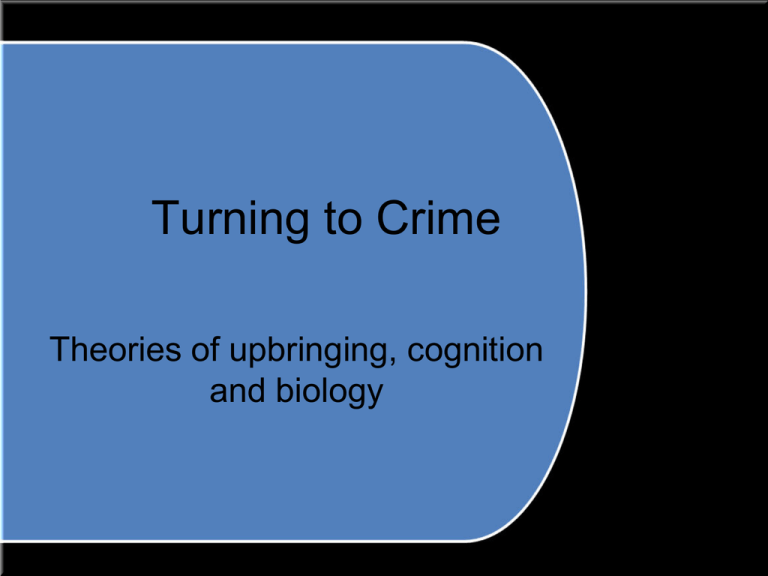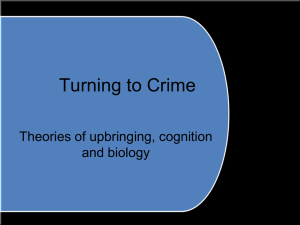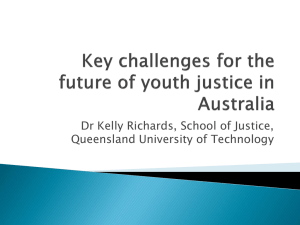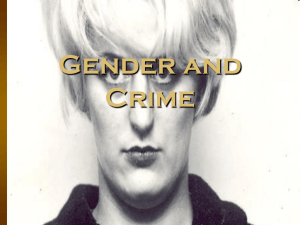
Turning to Crime
Theories of upbringing, cognition
and biology
What makes a criminal?
• Ronnie and Reggie Kray were a pair of identical
twins who were famous London gangsters in to
1960’s. They ran a number of nightclubs and
socialised with actors, lords and politicians, but
were also involved in robberies, arson, torture
and murder.
• A dedicated squad of detectives brought them to
justice in 1959 and they were both given life
sentences.
What makes a criminal?
• However, Ronnie suffered from paranoid
schizophrenia, was violent and volatile and
provoked most of their crimes.
• Reggie would have liked to go straight and turn
their business into an ordinary (or not especially
violent), criminal operation, but was dominated
by his brother.
• Were the two born into crime, or could things
have worked out differently? Discuss
How can we apply the approaches
and perspectives to crime?
Think… Pair… Share
•Behaviourist; ???
•Cognitive;???
•Psychodynamic;
•Bio-psychologists;
How can we apply the approaches
and perspectives to crime?
• Behaviourist;
– Looks at the behaviour of criminals and their environment and
works out what sort of backgrounds or circumstances turn
someone towards crime.
• Cognitive;
– Tries to study the thought processes of criminals, including how
they weigh up the odds, cope with guilt and think about getting
caught, to see what makes them different from everybody else.
• Psychodynamic;
– Psychologists argue that the real question isn ’ t why some
people turn to crime, but why the rest of us turn against it.
• Bio-psychologists;
– Interested in the brain structure of criminals and whether this
links with them having certain temperaments, personalities and
abilities.
Theories of Upbringing
Farrington, Bandura and Wikstrom
and Tafel.
What do psychologists mean by
upbringing?
• What do you think?
What do psychologists mean by
upbringing?
• Upbringing is a situational explanation of
behaviour; through interacting with people
such as friends and family, we learn how
to behave (or not to as may be the case!).
• When psychologists refer to upbringing as
the cause of crime they are taking a social,
developmental and social learning
approach.
How is upbringing connected to crime?
• Criminal behaviour is simply behaviour that is against the law; if you
start from this point then explaining criminal behaviour is the same
as explaining normal behaviour.
• It is widely accepted that parents, siblings and friends are major
determining factors in how a person behaves;
• if a person has social interactions and social learning that is
criminal, then the individual should develop into a criminal.
• Three significant areas of upbringing that can lead to criminal
behaviour are:
- ?
- ?
- ?
Three significant areas of upbringing that can lead
to criminal behaviour are:
• Disrupted families
• Learning from others (peers)
• Poverty
Disrupted families
• A disrupted family is any family that does not stay as a single unit;
families can break up through divorce, separation, death in a family,
or a member of the family being taken to prison. This is often seen
as a key indicator of risk to criminality.
• Maternal deprivation hypothesis (Bowlby, 1944) suggests that if a
child does not have constant contact in the first 2 years of life with
the mother they will not develop correctly. It is suggested that
individuals will have a higher risk of being aggressive, delinquent
and becoming an affectionless psychopath.
Learning from others
•Unlike the disrupted family theory, the learning from others explanation
does not distinguish between types of people, it is more involved in the
process of learning rather than who is involved.
•This approach is similar to social learning theory. This suggests that
behaviour can be learned through vicarious reinforcement
[observational learning - repeat behaviours that we see others
rewarded for performing]; a person does not need to be directly
involved to learn a new behaviour so long as the person they are
watching is seen as a model. Imitation is a key concept and was shown
to occur in the Bandura study from AS psychology.
Poverty
• The concept of poverty has historically
been associated with crime. If an
individual lives in a situation where they
are disadvantaged then they may have
cause to commit crime.
• This is because they are at high risk of
being in contact with crime; either as a
victim or a criminal.
2012: Top 10 crimes in the UK?
List the most common crimes you would
think are linked to the UK and then number
them 1 – 10 (1 being the most common).
2012: Top 10 crimes in the UK
• Criminal damage
• Theft and handling stolen goods (excluding car theft)
• Violence against the person
• Car theft (including theft from vehicles)
• Burglary (excluding domestic)
• Domestic burglary
• Fraud and forgery
• Drug offences
• Robbery
• Sexual offences
• (murder was not on there but you can consider it for the task)
With a partner mind-map why these people may turn to crime (then
categorise them)
•
-
Categories could include:
Upbringing
Cognition
Biology
- How?
Upbringing
• Farrington 2006 - The Cambridge study of
delinquent development (1)
• Bandura 1961 - Social learning theory and
the transmission of aggression (2)
• Wikstrom and Tafel 2003 – The
Peterborough Youth study (3)
Farrington 2006
The Cambridge study of
delinquent development
Aim:
• To document the start, beginning and end of
offending behaviour from childhood to adulthood
in families.
• To investigate the influence of life events and
the influence of family background on criminality.
Methodology:
• Longitudinal study.
• Data was gathered through interviewing the
participants over 40 years.
• Searches in criminal records gave information about
their criminality.
Participants:
• 411 boys aged between 8 and 9 at the start of the
study (born in 1953/1954).
• Taken from the registers of 6 state schools in East
London.
• Predominantly white and working class.
• 397 different families involved
• 14 pairs of brothers and 5 twins were in the sample.
• At age 48 when the final interview took place, 394
males were still alive and 365 were interviewed.
Findings:
• At age 48, 404 individuals searched in the criminal
records and 161 had convictions.
• The number of offences and offenders peaked at
age 17, followed by age 18.
• Those who started their criminal careers at age 1013 were nearly all reconvicted and committed on
average 9 crimes.
• Those who started their criminal careers at age 14 –
16 they committed an average of 6 crimes.
Findings:
• 7% of the males were defined as being chronic
offenders because they accounted for about half of
all the recorded offences.
• 93% admitted to committing at least one crime in
their life.
Findings:
• Most of the chronic offenders shared key childhood
characteristics;
–
–
–
–
–
–
–
–
Convicted before the age of 21
Had a convicted parent
High daring
Had a delinquent sibling
Young mothers
Low popularity
Disrupted families
Large family sizes.
• As Psychologists what would your
conclusions be?
• Work with a partner and feedback in 5
minutes.
Conclusions:
• Offenders tend to be deviant in many aspects of
their lives.
• Early prevention that reduces offending could have
a wide range of benefits in reducing problems later
in life.
• The most important risk factors include poverty,
impulsiveness, poor child-rearing and poor school
performance.
• What issues are there with this study?
Think… Pair… Share!
Issues:
• Generalisability
–
–
–
–
–
Cannot be generalised out of cities
All male sample
All from East London
Mostly white and working class
Large sample size
• Ethics
– No follow up for the individuals who dropped out
– All labelled as criminal children
• High ecological validity
Think back
to
Rosenhan
AS
Debates:
• Reductionism vs Holism
– Takes into account a variety of factors affecting
criminality
• Ethnocentrism
– All boys from East London
• Free will vs Determinism
– Your background and upbringing affects criminality
• Individual vs Situational
• Nature vs Nurture
Bandura 1961
Social learning theory and the
transmission of aggression.
Background
• Social learning theory, or SLT, is the theory that
people
learn
new
behaviours
through
observational learning.
• If a person observes a positive, desired outcome
from the behaviour observed, they are more
likely to model, imitate and thus adopt this
behaviour for themselves.
Aim:
• To see if children modelled aggression in a new
setting.
• To investigate sex differences based on the
principles of social learning theory.
Methodology:
• Lab experiment.
• Independent measures design.
• Matched pairs design.
Variables:
• Three independent variables;
– The sex of the child
– The sex of the model
– The behaviour of the model.
Participants:
• 72 children, 36 male and 36 female.
• All from Stanford University Nursery School.
• Ranged from 3 years and 1 month to 5 years
and 9 months.
• The children were matched on the basis of their
pre-existing aggression levels. These were rated
on a 5-point likert scale by their nursery teacher
and the experimenter.
Procedure – Stage One:
• The children were exposed to the adult model
individually.
• In the aggressive condition the model acted out
a series of pre-planned aggressive acts towards
the Bobo doll.
• In the non-aggressive condition, the model
played quietly.
Procedure- Stage Two:
• This stage was the mild aggression arousal
stage.
• The children were briefly sown some attractive
toys and then told that they weren’t allowed to
play with these.
Procedure- Stage Three:
• Observation of delayed imitation that lasted for
20 minutes.
• Observers watched the children play in a room
filled with aggressive and non-aggressive toys,
through a one way mirror.
• Three measures of imitation were obtained;
– Imitative physical aggression
– Imitative verbal aggression
– Imitative non-aggressive verbal reponses.
• What findings would you expect to see?...
You should know this anyway!
Findings:
• Boys were more physically aggressive than girls.
• The children in the aggressive condition made
more aggressive responses.
• Girls in the aggressive model condition showed
more physical aggression f the model was male
and more verbal aggression if the model was
female.
• Boys were more likely to imitate same sex
models than girls.
• What conclusions would you make?
Conclusions:
• The findings support Bandura’s Social Learning
Theory.
• Applying this to criminality, when a person,
especially a child, sees a role model performing
a behaviour and then receiving reinforcement
this is remembered.
• When given an opportunity to imitate this
behaviour, they will do so and of they get
reinforcement, will continue to do so.
• With a partner discuss and mind map the
main issues of the study…
Issues:
• Ethics
– The use of children- Can they really give their permission?
– Protection from harm- were they aggressive in the future?
• Generalisability
– Large sample size
– All from one area
– All from one university nursery- prestigious
• Reliability
– Controlled lab experiment so can be replicated
• Validity
– Low ecological validity due to it being a lab experiment.
Debates:
• Ethnocentrism
• Situational vs individual
Wikstrom and Tafel
2003
The Peterborough Youth Study
Aim:
• To investigate why young people offend
Methodology:
• A cross-sectional study (type of observational
study that involves the analysis of data collected
from a population)
• Carried out on nearly 2000 year 10 students
aged 14-15.
• Data was collected from official records.
• Students were all interviewed.
Findings:
• 44.8% of males and 30.6% of females had
committed at least one crime during the year
2000. These included acts of violence, theft and
vandalism.
• 9.8% of males and 3.8% of females had
committed one serious act of theft.
• High-frequency offenders committed a wide
range of crimes.
• 1 in 8 were reported to or caught by the police
for their last offence.
Findings:
• Offenders are victimised more than nonoffenders.
• Violent offenders are more likely to become
victims of violence.
• Offenders are more likely to abuse drink and
drugs.
Explanatory factors:
• Family social position
– Social class, ethnicity and family composition
• Individual characteristics
– Self-control, morality, family bonds and monitoring
• Social situation
– Family and school bonds, opportunity for truancy
• Lifestyle and routine activities
• Community context
– Neighbourhood disadvantage and school attended.
Conclusions:
•
Wikstrom and Tafel suggested three groups of adolescent
offenders:
1.
Propensity (natural tendency) induced;
•
Have an enduring propensity to offend. A small group,
responsible for a disproportionate number of offences.
•
Risk factors include, weak family and social bonds, low levels
of self control and low levels of shame.
2.
Lifestyle dependent
•
Average in terms of social adjustment. Offend when they have
high-risk lifestyles- drink or drugs.
3.
Situationally limited
•
Occasionally offend. Exposed to high levels of situational risk.
Unlikely to reoffend.
Debates:
• Determinism vs Free will
– The influence of others affects criminal behaviours,
however it acknowledges individual differences
• Nature vs Nurture
– The environment and people we are associated with
explain why people turn to crime
• Reductionism vs Holism
– Looks at a variety of factors influencing criminality.











